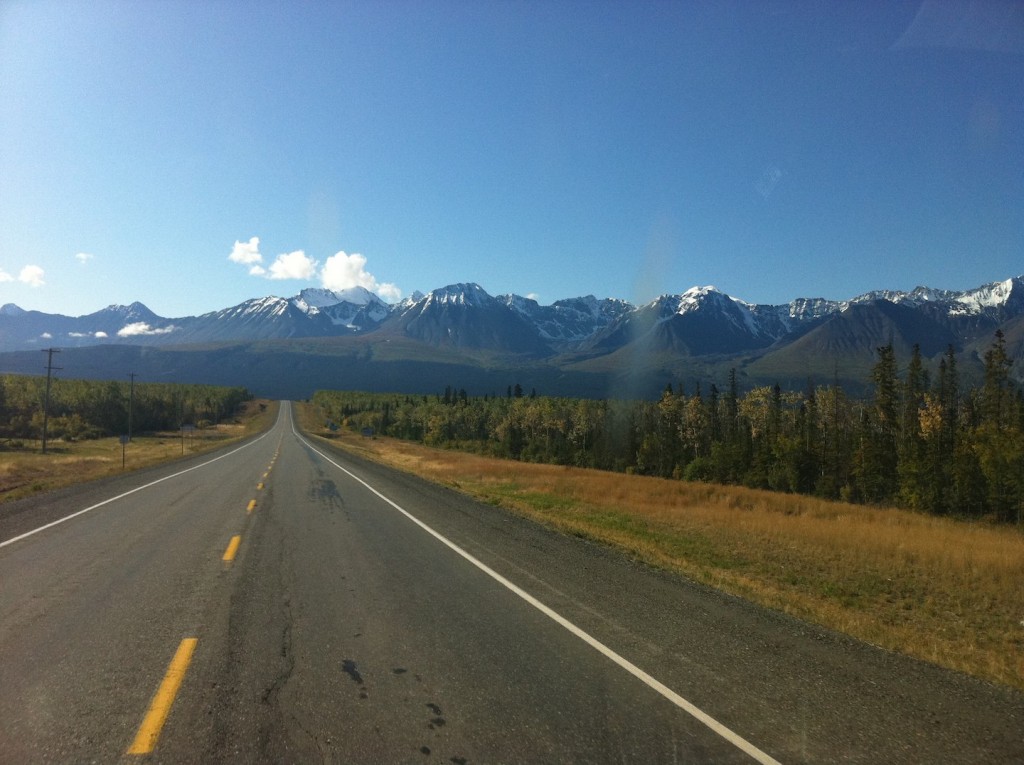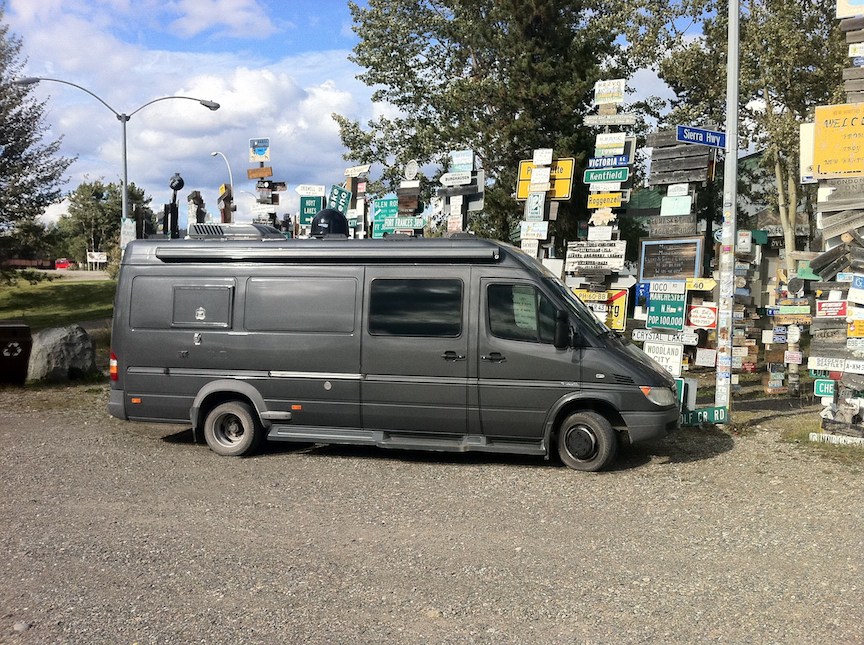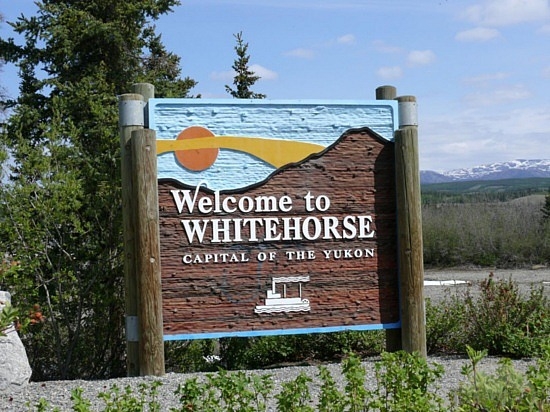So where were we? Oh, yeah, getting pulled over in Calgary on suspicion of do-it-yourself license plates.
Calgary, (which, for those of you scoring at home, is 400 miles north of Missoula, Montana) was the furthest north I’d ever driven. I’ve traveled to more northern locations — to Churchill, Manitoba, Inuvik in the Northwest Territories, Dutch Harbor in the Alaskan Aleutian islands. But I’d gotten to all those places by either train or plane. For some reason – and mental illness would be a good guess – I decided it was important to see how far north I could get in my own vehicle. I mean, yes, I’ve already accomplished a lot in my life. I do have a number of Foursquare badges.
But, as meaningless accomplishments go, driving all the way to Alaska this would a big one, right up there with that time in 6th grade when I convinced the other kids at Creswell Elementary that I was a professional wrestler on weekends and “proved” it by slamming my own head into a tree trunk. I know. This explains a lot.
So, from Calgary, I drove 200 miles north to Edmonton, where I stayed long enough to find out that:
a) The Wayne Gretzky Statue is a coward and will not fight you no matter how many times you call it a pussy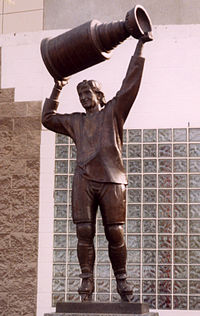
b) Edmonton is the home of the world’s second largest Fringe Festival, which means that for a few weeks in late summer, the place is infested with jugglers and mimes. Some of them WILL fight you, although ducking a mime punch is a ridiculously easy thing to do. Jugglers, on the other hand, will fuck you up. And a lot of them carry knives.
b-plus) One of the coolest guys at the Fringe Festival (which actually is pretty great, I mean, there’s an anti-circumcision improv show in a tent. No, really, there is.) is named Joey Hundert . He runs what I believe to be the world’s only bio-diesel powered amusement rides. He calls it Sustainaval and it features, among other things, a Gravitron that smells like french fries. I should probably write an actual story about this.
c) The giant Edmonton mall is so big that Crabtree and Evelyn have separate stores. Also there’s a water park and roller coasters and a pirate ship and a comedy club and probably a juggler-and-mime store hidden somewhere in the back. The best part of being there was that I was the only person who wasn’t worried about whether they could find their car in the parking lot.
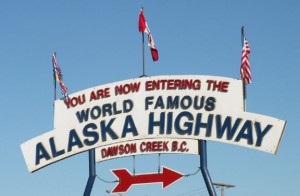 The actual Alaska Highway starts in Dawson Creek, B.C, about 375 miles northwest of Edmonton. At that point it still feels like pretty much any rural highway, nicely paved, well-lit, stoplights in the middle of towns, McDonalds and Wal Marts readily available.
The actual Alaska Highway starts in Dawson Creek, B.C, about 375 miles northwest of Edmonton. At that point it still feels like pretty much any rural highway, nicely paved, well-lit, stoplights in the middle of towns, McDonalds and Wal Marts readily available.
The Mile Zero signpost for the Alaska Highway is there because, prior to the construction of the road to Alaska in 1942, there wasn’t any reliable way of going north or west. People got around by bush plane for the most part and other than hunters, trappers and gold miners, there weren’t many people headed in that direction.
But then the Nazi’s bombed Pearl Harbor (I get all my historical information from Michelle Bachmann and John Blutarsky) and everybody decided there needed to be a highway to get to Alaska and the northern pacific coast. When the Russians invaded, they would then have an easy way to drive all the way to Seattle. In gratitude, they would not put everyone in gulags and/or force us to eat beets for breakfast. I’m not sure how all that stuffed worked out, but the highway got built. (Actual history here.)
It’s 1520 miles from Dawson Creek to Fairbanks, through northern British Columbia and across the Yukon Territory. It’s a long 3-day drive if nothing goes wrong. Which means no one makes it in 3 days.
It doesn’t start feeling really remote until you get past Fort Nelson, which is 300 miles north of Dawson Creek. Up to there, it’s just like any other a country highway, small towns every 20 miles or so, the prairie giving way to foothills, the poplars and aspens starting to get thicker, the horizons a little emptier.
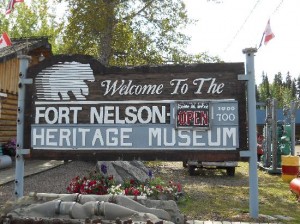 Fort Nelson, though, feels like an outpost, full of truck drivers and oil workers, guys who have come out to the frontier to make a fortune. And they are. This is tar sands country, the goopy thick oil they squeeze out of the ground and want to pipe to the U.S. in that now-delayed Keystone XL Pipeline. So there are rigs everywhere. And lots of guys in mud-caked jumpsuits, underneath which they are wearing “Slayer” t-shirts. They show up at Dan’s Neighbourhood Pub on a Friday night, cause they don’t have anywhere else to go. They drink Rickard’s Red and the only women in the place are the waitresses, who have various degrees of resignation, acceptance and defeat in their eyes, depending on their age. The youngest one, in her 20’s, still smiles. The others don’t bother anymore.
Fort Nelson, though, feels like an outpost, full of truck drivers and oil workers, guys who have come out to the frontier to make a fortune. And they are. This is tar sands country, the goopy thick oil they squeeze out of the ground and want to pipe to the U.S. in that now-delayed Keystone XL Pipeline. So there are rigs everywhere. And lots of guys in mud-caked jumpsuits, underneath which they are wearing “Slayer” t-shirts. They show up at Dan’s Neighbourhood Pub on a Friday night, cause they don’t have anywhere else to go. They drink Rickard’s Red and the only women in the place are the waitresses, who have various degrees of resignation, acceptance and defeat in their eyes, depending on their age. The youngest one, in her 20’s, still smiles. The others don’t bother anymore.
On the plus side, there are several places to buy donuts, the last vestige of a civilized society for hundreds of miles.
Once you get west of Fort Nelson, the distances get more daunting and the scenery more impressive. There are 100 mile stretches between towns, which usually consist of nothing more than a gas station and a trailer-park motel. But there are glaciers and mountains and forests that stretch forever. There are bears hanging out by the side of the road as if they’re looking to hitch a ride. There are mountain goats and reindeer herds. And also there are lots of construction crews.
Every 50 miles or so, there’s someone with a flag, urging you to slow down before you enter a mile-long section of unpaved road, sometimes dirt, sometimes gravel, sometimes mud. A couple of these stretches are so bad that you have to wait for a pilot car to guide you through, the dust cloud so overwhelming that you can barely see the flashing yellow lights just in front of you. Occasionally, the dust dissipates long enough for you to realize that you are driving alongside a cliff and that one wrong turn sends you 100 feet down into Summit Lake. So, to be on the safe side, you eat the last of your donuts.
There’s even a herd of bison in the Liard River Provincial Park, just before you cross over into the Yukon. They wander back and forth across the highway, grazing at their leisure. When they decide to cross, you wait. And there are signs strongly suggesting that you not drive this stretch after dark, because the buffalo tend to hang out in the middle of highway. Also, you can’t roller skate. (Roger Miller reference, everybody! High five!)
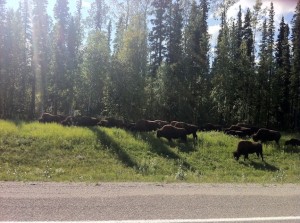 For a while I was following two brand-new Federal Express Sprinters being driven from the factory (in South Carolina) to Anchorage. They were driven by a retired married couple from Oklahoma who do this for a living. Federal Express flies them to the factory, gives them a destination (they’d been this way a half-dozen times before) and then flies them back home. Possible future career duly noted.
For a while I was following two brand-new Federal Express Sprinters being driven from the factory (in South Carolina) to Anchorage. They were driven by a retired married couple from Oklahoma who do this for a living. Federal Express flies them to the factory, gives them a destination (they’d been this way a half-dozen times before) and then flies them back home. Possible future career duly noted.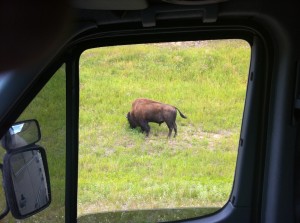
I made it all the way to Watson Lake, home of the famous signpost village, 400 miles from Fort Nelson, in a single day, early enough that I decided to keep going. What the hell, another 100 miles or so wouldn’t make any difference. The Traipsemobile was cruising. I had beer in the fridge. Plus, I’d already seen a couple of bears. Maybe I’d see a couple of more before sunset. I was having a spectacular day.
And then, about 60 miles past Watson Lake, with the cruise control on, the Traipsemobile suddenly lost power. I’d just bought diesel and my first thought was that there’d been something wrong with the fuel. Then I thought it was the transmission. Whatever the reason – and nothing like this had ever happened before – I appeared to be losing power, unable to go more than 30 miles an hour, even less on uphill grades. I assumed the engine was about to conk out. Did I mention I’d just seen bears?
There was, allegedly, a town called Rancheria about 40 miles ahead. The sun was going down. Turning around seemed riskier than going ahead. I’d have to limp along for as long as I could. I was in the middle of nowhere, going about 25 miles an hour most of the way, convinced I was about to spend the night by the side of the road.
But the Traipsemobile didn’t die. It kept chugging along, me sweating out every agonizingly-slow uphill climb. Also, I was out of donuts.
Rancheria was, in its entirety, a gas station, a motel and a diner. A way station for truckers, mostly. But the guy who owned it said he knew a little something about diesel engines. And the closest mechanic was 200 miles away in Whitehorse. He’d do what he could.
Which was nothing. He fiddled around with the engine, I looked on and nodded as if I knew what he was doing. We determined, by means of a couple of high-acceleration attempts in the parking lot, that the engine probably wouldn’t die, it just wasn’t going to get beyond second gear. His suggestion was that I spend the night and then try limping to Whitehorse the following day.
And that’s what I did. It was 40 degrees and raining and trucks were passing me at frightening speeds. Also – a new development – the Traipsemobile was spewing black exhaust and, every few minutes, the carbon monoxide alarm in the van would go off, forcing me to drive with the windows down.
But I made it, after a sputtering 7 hour drive,, never going faster than 50 miles an hour (downhill). It wasn’t that bad, really, being that far from other people, having plenty of time to appreciate the vastness of it all. In the end I decided it had been kind of fun.
Of course, I still didn’t know what was wrong with the Traipsemobile. It would be 3 days before a mechanic could even look at it and, having never worked on a Sprinter before, he wasn’t making any promises.
So there wasn’t anything to do but hang around Whitehorse, home of the Yukon Brewing company and a number of fine drinking establishments, including the Gold Pan Saloon. Fairbanks was still 500 miles away. But, what the hell, I’d been stranded in worse places. Whitehorse even had a great coffee shop, called Baked. They had donuts. I’d be fine.
